Sustaining STEM with Leadership Development
A MiddleWeb Blog
 Implementing and sustaining a STEM program – in a school or across a school system – requires a lot of research and planning. One important piece of this work that’s often overlooked: a well-designed plan for broad leadership development. Why “broad”? Because sustainability depends on knowledgeable and energetic leadership across many sectors.
Implementing and sustaining a STEM program – in a school or across a school system – requires a lot of research and planning. One important piece of this work that’s often overlooked: a well-designed plan for broad leadership development. Why “broad”? Because sustainability depends on knowledgeable and energetic leadership across many sectors.
To learn about the best ways to design a STEM leadership development initiative, I once again went to a real expert, Dr. Susan Pruet, who recently contributed her thoughts about how to develop a top-notch STEM program.
Susan has successfully established two community-wide programs in the Mobile County Public School System (MCPSS) – the largest school district in Alabama. Both programs depended upon the support not only of school system leadership but key leaders in the business and civic community. So I’ve asked her to share her lessons learned as she spearheaded the evolution of Mobile’s comprehensive STEM Leadership Program. Once again . . . here’s Susan!
____________________________
Building a STEM Leadership Academy

Great STEM programs are great community programs. We want STEM initiatives to engage and prepare more students to pursue STEM-related careers – both to benefit them personally and to help our communities prosper. Support from well-informed and committed leaders is how we get all the way to great.
Getting Started
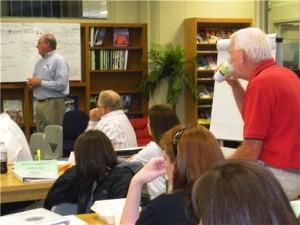
Unsurprisingly, we found the biggest issue we faced was the ever-present and compelling status quo that threatened to suck us back to our old ways. We intended these new STEM practices to become institutionalized; to become simply the way that Mobile County “does school.” We needed a status quo intervention – a critical mass of strong leadership across multiple sectors to sustain, support and eventually expand our STEM programs to more schools.
Funding from the Toyota USA Foundation helped us develop a STEM leadership program. We dubbed this program the EYE on STEM Leadership Academy. (EYE was short for the name of our local STEM program, Engaging Youth through Engineering.)
Building a Leadership Structure
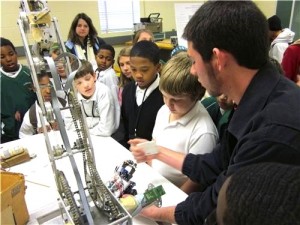
The four groups of stakeholders we decided must be included are:
- Business and industry leaders. These folk provide needed ongoing advocacy to those who make and enforce policy; for example – the school board. Advocacy is huge when you tackle the status quo. They can also serve as STEM lab volunteers and find grants and other financial resources.
- District and school leaders. This broad category includes basically anyone who designs programs and/or influences or supports instruction. They might be district leaders responsible for core curriculum, instruction and assessment (the “holy three” when undertaking any education reform!), as well as leaders in other departments. At the school level we included principals and math and science department chairs.
- Teacher educators. This tier includes anyone who provides continuing education for STEM-related teachers: college-based teacher educators, coaches from other district-wide science or math initiatives, and informal science educators (such as professional developers from our local science museum, sea lab and environmental center, to name a few).
- Classroom math, science, and technology teacher leaders. From this tier will come knowledgeable STEM teacher leaders, who have successfully implemented STEM in their own classrooms and also are able to support other grade-level teachers as they develop STEM know-how.
Building the Common STEM Vision across All Tiers
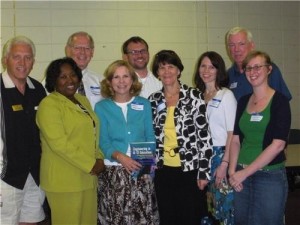
- STEM Community Leaders Breakfast. This event targeted key business and education leaders – the “influencers, movers, and shakers.” We brought in a high-profile national STEM leader – in this case, Liz Parry – then chair of the K-12 Division of the American Society of Engineering Educators. Parry’s presentation shared the national perspective on K-12 STEM needs. Having followed our program for several years, Parry provided critical validation of our STEM direction.
- STEM for All Leadership Conference. For the remaining three tiers we held a STEM for All conference prior to the beginning of school. We brought all groups together to affirm the what, why, and how of STEM. They took part in STEM lessons to make the “how” of STEM concrete for them. Liz Parry returned as keynote speaker, extending a consistent and powerful focus across all tiers.
Building Unique STEM Leadership Skills for 2 Tiers
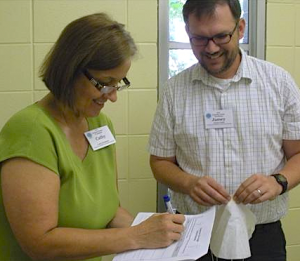
- The STEM Seminar Series targeted science and math teacher educators from our local universities and was open to anyone providing STEM-related professional development. This well-received series was led by the developers of our middle grades STEM curriculum (the EYE Modules). Each Seminar used a design challenge from a different EYE Module to illustrate a particular characteristic of integrated STEM (that is, the seamless integration of math and science). The series culminated with on-site observations of teachers implementing one of the Modules.
- The Academy’s STEM Teacher Leadership Program focused on the fourth tier: classroom teacher leaders. Based on recommendations from participants in the STEM Seminar Series, we invited teachers to apply and then used a criteria-driven selection process to ensure our STEM teacher leaders were qualified and met our needs. Our program curriculum emphasized 3 strands: applied content, STEM practices, and leadership skills, including understanding the change process. By the end of the two-year program, we wanted our STEM Teacher Leaders to be experts in implementing engineering-focused STEM challenges, to be able to virtually support other teachers learning to implement STEM, and to use their leadership skills to serve as change agents.
The Pay-Off
Our STEM leadership development program is beginning to pay big dividends. The school system is actively supporting, sustaining, and expanding the STEM program. For example, it hired its first district-level STEM Specialist to help direct and coordinate all STEM efforts, including the Teacher Leadership Program.
The final task for our STEM leaders is to collaboratively develop a written document that maps out what is needed to support, sustain, and scale up the STEM program, given their multiple perspectives. This will become the Mobile area blueprint for long-term STEM reform.
Anne, again . . .
As Susan always reminds me, no one silver bullet works for everyone, everywhere. Your leadership development plan must match your community and STEM program. That said, I’m confident that her successful work in this area over a sustained period of years in a high-tech region of the Southeast has resulted in advice you can use.
Dr. Susan Pruet is President of STEMWorks LLC and served as principal investigator for the Mobile Area Education Foundation for 13 years, during which time she led a multimillion-dollar NSF grant to develop STEM curriculum for the middle grades. She enjoys using her expertise to work with districts in developing STEM and Leadership Development programs. Contact her at susan.stemworks@gmail.com.

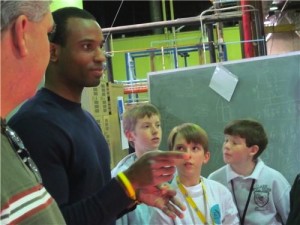





























I totally agree with all that was stated – especially about the four stakeholder groups. I am working with a non-profit that connects education and business called Spark101 (www.spark101.org) This free resource is cool as it offers engaging, on-demand videos (that are short) with the focus on students solving real-world STEM problems presented by industry experts. The videos end with presenters sharing their passion for and advice about college and careers (some of which are pretty unusual). It is worth checking out if you haven’t seen it. :-)
Thanks, Shelley! I’ll check it out. Free resources are in short supply these days.
Great information! Anything for 9-12?